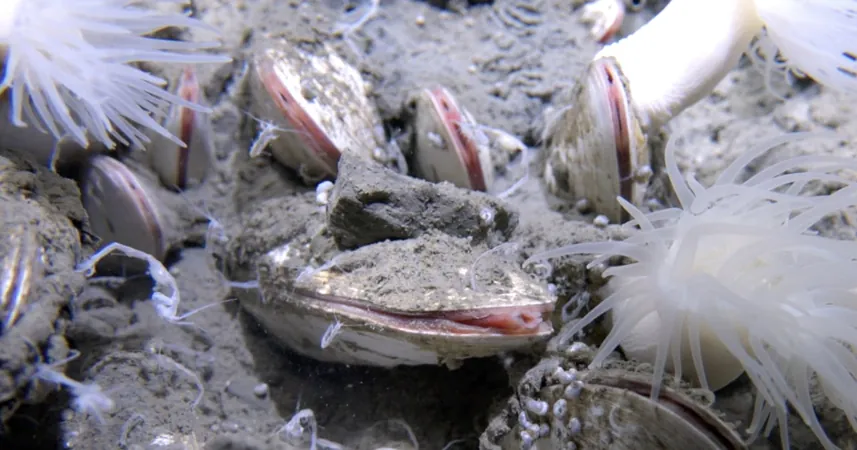
Unveiling a Hidden Paradise: Scientists Discover Vibrant Ecosystem Deep Beneath the Pacific
2025-07-31
Author: Ling
A Submersible Odyssey 30,000 Feet Below the Surface
In an astounding venture, researchers aboard a cutting-edge submersible have unearthed a captivating ecosystem nestled a staggering 30,000 feet below the waves of the Pacific Ocean—deeper than Mount Everest is tall. This remarkable expedition, led by a Chinese research team, revealed a world unlike any other beneath the sea.
A Garden of Life in the Abyss
Imagine fields brimming with vivid marine worms gliding through clusters of bright red tubes—resembling flowers sprouting from the ocean floor. The team also discovered dense patches of clams reaching up to 9 inches in length and vast microbial mats that covered the landscape like a fluffy layer of snow. Dominic Papineau, a senior researcher from the Chinese Academy of Sciences, exuberantly stated, "This marks the first direct observation of chemosynthesis-based communities at such extreme depths." This groundbreaking finding suggests that life in hadal trenches, often characterized by their unimaginable depths, is infinitely more diverse than previously believed.
Chemosynthesis: The Heartbeat of the Deep
In these shadowy realms, sunlight never penetrates, leading organisms here to rely on chemosynthesis—the process of transforming chemicals into energy—as their primary source of sustenance. The creatures thrive by hosting microbes that metabolize methane and hydrogen sulfide, both abundant in these deep sea environments.
An Astounding Discovery in Hadal Trenches
Hadal trenches, which form where tectonic plates collide, are believed to house vast communities based on chemosynthesis. However, signs of thriving, large life forms presented an unusual surprise to marine ecologist Kareen Schnabel, who observed, "You wouldn’t expect such abundance in these extreme depths given the immense pressures and conditions present." The pressure at these depths can reach a staggering 98 megapascals—more than six times the force of an alligator's bite.
An Expedition to Remember
The dives that revealed this hidden paradise took place in July and August of last year. The research team explored two major trenches: the Kuril-Kamchatka Trench, stretching over 1,300 miles, and the imposing Aleutian Trench, which spans 1,800 miles.
The Thrill and Terror of Deep-Sea Exploration
Recollecting her own adventures in the same submersible, Fendouzhe, Schnabel reflected on the intense mix of excitement and apprehension that accompanies such plunges into the abyss. "You're suspended above a massive 10-kilometer void in the Earth," she shared, emphasizing the confined and surreal experience of peering through a tiny, 4.7-inch window. Yet, her astonishment at encountering an unexpected abundance of life was overwhelming. "I was stunned by the multitude of animals that thrived at the ocean's depths," she recalled, challenging existing notions of life's limits.
Expanding Our Understanding of Deep-Sea Life
These revolutionary discoveries mark a significant breakthrough in our comprehension of life in extreme environments. The researchers concluded that these chemosynthesis-based ecosystems may be far more widespread than previously thought, revolutionizing our approach to understanding marine biology and the ecosystems that dwell in the ocean's twilight zone.





 Brasil (PT)
Brasil (PT)
 Canada (EN)
Canada (EN)
 Chile (ES)
Chile (ES)
 Česko (CS)
Česko (CS)
 대한민국 (KO)
대한민국 (KO)
 España (ES)
España (ES)
 France (FR)
France (FR)
 Hong Kong (EN)
Hong Kong (EN)
 Italia (IT)
Italia (IT)
 日本 (JA)
日本 (JA)
 Magyarország (HU)
Magyarország (HU)
 Norge (NO)
Norge (NO)
 Polska (PL)
Polska (PL)
 Schweiz (DE)
Schweiz (DE)
 Singapore (EN)
Singapore (EN)
 Sverige (SV)
Sverige (SV)
 Suomi (FI)
Suomi (FI)
 Türkiye (TR)
Türkiye (TR)
 الإمارات العربية المتحدة (AR)
الإمارات العربية المتحدة (AR)